Exploring Text Mining for Recent Consumer and Sensory Studies about Alternative Proteins
Abstract
:1. Introduction
2. Materials and Methods
2.1. Selection of Papers
2.2. Processing of Papers and Texts
2.3. Text Mining
2.3.1. Web Scraping
2.3.2. PDF Scraping and Text Processing
2.3.3. Text Scraping and Natural Language Processing
2.4. Statistical Analysis
3. Results and Discussion
3.1. Word Frequency
3.2. Relevance between Different Words
| 1. Insect | ||||
| Willing (0.38) | Neophobia (0.37) | Cockroach (0.34) | Disgust (0.33) | Novel (0.33) |
| 2. Accept | ||||
| Don’t (0.45) | Adult (0.31) | Barrier (0.29) | Elder (0.29) | |
| 3. Like | ||||
| Tomato (0.41) | Spirulinarel (0.30) | Negat (0.29) | ||
| 4. Plantbase | ||||
| Health (0.26) | Insectsbas (0.26) | Asia (0.25) | ||
| 5. Expect | ||||
| Disappoint (0.35) | Novel (0.30) | Reject (0.29) | ||
| 6. Pea | ||||
| Lupin (0.54) | Mushroomi (0.51) | Dusti (0.49) | Green (0.45) | Nut (0.40) |
| Earthi (0.38) | Bitter (0.34) | |||
3.3. Emotions Analysis
| Paper No. | Alternative Protein Types | Percentage of Each Emotion in the Text (%) | |||||||
| Trust | Joy | Anticipation | Sadness | Fear | Disgust | Anger | Surprise | ||
| 1 | Plant | 30 | 18 | 14 | 8 | 10 | 7 | 7 | 6 |
| 2 | Plant, insect | 34 | 17 | 16 | 9 | 7.5 | 7.5 | 9 | 0 |
| 3 | Plant, insect | 23 | 14 | 17 | 15 | 11 | 6 | 7 | 7 |
| 4 | Plant | 22 | 13.5 | 17 | 15 | 11 | 6.5 | 7.5 | 7.5 |
| 5 | Plant, insect | 40 | 21 | 13 | 6.5 | 5.5 | 4 | 5 | 5 |
| 6 | Insect, algae | 27.5 | 17.5 | 19 | 8 | 5 | 11 | 6 | 6 |
| 7 | Plant, insect, cultured meat | 32 | 20 | 14 | 11 | 10 | 4 | 4 | 5 |
| 8 | Insect | 23 | 16 | 14 | 11 | 11 | 9.5 | 11 | 4.5 |
| 9 | Plant | 35 | 17 | 29 | 4 | 4 | 3.5 | 0 | 7.5 |
| 10 | Plant | 28 | 14 | 16 | 16.5 | 13 | 1 | 4 | 7.5 |
| 11 | Plant | 19 | 14.5 | 13.5 | 12.5 | 13.5 | 8.5 | 7.5 | 11 |
| 12 | Plant | 34 | 12 | 26 | 14 | 4 | 4 | 6 | 0 |
| 13 | Plant, algae | 41 | 16 | 8.5 | 10.5 | 7 | 5 | 4 | 8 |
| 14 | Plant | 26 | 14 | 13 | 12 | 5.5 | 12.5 | 10 | 7 |
| 15 | Algae | 32 | 23 | 14 | 10 | 5 | 8 | 5 | 3 |
| 16 | Plant, insect, algae, cultured meat | 36 | 20 | 15 | 10 | 7 | 4 | 6 | 2 |
| 17 | Plant | 30 | 15 | 15.5 | 11.5 | 10 | 5 | 6.5 | 6.5 |
| 18 | Insect | 31 | 16.5 | 20 | 9.5 | 2.5 | 6 | 5 | 9.5 |
| 19 | Plant | 32 | 27.5 | 11.5 | 6 | 11.5 | 0 | 0 | 11.5 |
| 20 | Insect | 24 | 16 | 11 | 9 | 14.5 | 14 | 8 | 3.5 |
3.4. Comparison with Other Text Mining Works
4. Conclusions
Supplementary Materials
Author Contributions
Funding
Data Availability Statement
Conflicts of Interest
References
- Fiorentini, M.; Kinchla, A.J.; Nolden, A.A. Role of Sensory Evaluation in Consumer Acceptance of Plant-Based Meat Analogs and Meat Extenders: A Scoping Review. Foods 2020, 9, 1334. [Google Scholar] [CrossRef]
- Foote, K.J.; Joy, M.K.; Death, R.G. New Zealand Dairy Farming: Milking our Environment for all Its Worth. Environ. Manag. 2015, 56, 709–720. [Google Scholar] [CrossRef]
- Giacomelli, M.; Salata, C.; Martini, M.; Montesissa, C.; Piccirillo, A. Antimicrobial Resistance of Campylobacter jejuni and Campylobacter coli from Poultry in Italy. Microb. Drug Resist. 2014, 20, 181–188. [Google Scholar] [CrossRef] [PubMed]
- Nawaz, M.F.; Bourrie, G.; Trolard, F. Soil Compaction Impact and Modelling. A Review. Agron. Sustain. Dev. 2013, 33, 291–309. [Google Scholar] [CrossRef]
- Meat Alternatives and the Alternative Protein Market. Available online: https://www.fairr.org/article/alternative-protein-market/ (accessed on 14 January 2021).
- Verbeke, W.; Sans, P.; Van Loo, E.J. Challenges and Prospects for Consumer Acceptance of Cultured Meat. J. Integr. Agric. 2015, 14, 285–294. [Google Scholar] [CrossRef]
- Heymann, H.; King, E.S.; Hopfer, H. Classical Descriptive Analysis, 1st ed.; CRC Press: New York, NY, USA, 2014; pp. 9–40. [Google Scholar]
- Lawless, H.T.; Heymann, H. Sensory Evaluation of Food: Principles and Practices, 1st ed.; Springer Science & Business Media: New York, NY, USA, 2010; pp. 227–252. [Google Scholar]
- Spinelli, S.; Dinnella, C.; Masi, C.; Zoboli, G.P.; Prescott, J.; Monteleone, E. Investigating Preferred Coffee Consumption Contexts using Open-Ended Questions. Food Qual. Prefer. 2017, 61, 63–73. [Google Scholar] [CrossRef]
- Delarue, J.; Lawlor, B. Rapid Sensory Profiling Techniques: Applications in New Product Development and Consumer Research, 1st ed.; Woodhead Publishing: Cambridge, UK, 2014; pp. 27–50. [Google Scholar]
- Bakhtin, P.; Khabirova, E.; Kuzminov, I.; Thurner, T. The Future of Food Production–A Text-Mining Approach. Technol. Anal. Strateg. Manag. 2020, 32, 516–528. [Google Scholar] [CrossRef]
- Bécue-Bertaut, M.; Álvarez-Esteban, R.; Pagès, J. Rating of Products through Scores and Free-Text Assertions: Comparing and Combining Both. Food Qual. Prefer. 2008, 19, 122–134. [Google Scholar] [CrossRef]
- Zong, C.M.; Wang, H.B.; Du, X.J. The Application of Data Mining in the Food Manufacturing Industry. Appl. Mech. Mater. 2010, 20, 856–860. [Google Scholar] [CrossRef]
- Hamilton, M.L.; Jacob, L. Fast and Automated Sensory Analysis: Using Natural Language Processing for Descriptive Lexicon Development. Food Qual. Prefer. 2020, 83, 103926. [Google Scholar] [CrossRef]
- R: A Language and Environment for Statistical Computing. Available online: https://www.r-project.org (accessed on 29 January 2021).
- Ickes, C.M.; Lee, S.Y.; Cadwallader, K.R. Novel Creation of a Rum Flavor Lexicon through the Use of Web-Based Material. J. Food Sci. 2017, 82, 1216–1223. [Google Scholar] [CrossRef]
- Red-Gate. Text Mining and Sentiment Analysis. Available online: https://www.red-gate.com/simple-talk/sql/bi/text-mining-and-sentiment-analysis-with-r/ (accessed on 29 January 2021).
- Cosson, A.; Delarue, J.; Mabille, A.C.; Druon, A.; Descamps, N.; Roturier, J.M.; Souchon, I.; Saint-Eve, A. Block Protocol for Conventional Profiling to Sensory Characterise Plant Protein Isolates. Food Qual. Prefer. 2020, 83, 103927. [Google Scholar] [CrossRef]
- García-Segovia, P.; Igual, M.; Martínez-Monzó, J. Physicochemical Properties and Consumer Acceptance of Bread Enriched with Alternative Proteins. Foods 2020, 9, 933. [Google Scholar] [CrossRef]
- Kaleda, A.; Talvistu, K.; Tamm, M.; Viirma, M.; Rosend, J.; Tanilas, K.; Kriisa, M.; Part, N.; Tammik, M.L. Impact of Fermentation and Phytase Treatment of Pea-Oat Protein Blend on Physicochemical, Sensory, and Nutritional Properties of Extruded Meat Analogs. Foods 2020, 9, 1059. [Google Scholar] [CrossRef]
- Martin, C.; Lange, C.; Marette, S. Importance of Additional Information, as a Complement to Information Coming from Packaging, to Promote Meat Substitutes: A Case Study on a Sausage Based on Vegetable Proteins. Food Qual. Prefer. 2021, 87, 104058. [Google Scholar] [CrossRef]
- Sha, L.; Xiong, Y.L. Plant Protein-Based Alternatives of Reconstructed Meat: Science, Technology, and Challenges. Trends Food Sci. Technol. 2020, 102, 51–61. [Google Scholar] [CrossRef]
- Stephan, A.; Ahlborn, J.; Zajul, M.; Zorn, H. Edible Mushroom Mycelia of Pleurotus sapidus as Novel Protein Sources in a Vegan Boiled Sausage Analog System: Functionality and Sensory Tests in Comparison to Commercial Proteins and Meat Sausages. Eur. Food Res. Technol. 2018, 244, 913–924. [Google Scholar] [CrossRef]
- Yuliarti, O.; Kovis, T.J.K.; Yi, N.J. Structuring the Meat Analogue by Using Plant-Based Derived Composites. J. Food Eng. 2021, 288, 110138. [Google Scholar] [CrossRef]
- Grahl, S.; Strack, M.; Mensching, A.; Mörlein, D. Alternative Protein Sources in Western Diets: Food Product Development and Consumer Acceptance of Spirulina-Filled Pasta. Food Qual. Prefer. 2020, 84, 103933. [Google Scholar] [CrossRef]
- Gurdian, C.E.; Torrico, D.D.; Li, B.; Tuuri, G.; Prinyawiwatkul, W. Effect of Disclosed Information on Product Liking, Emotional Profile and Purchase Intent: A Case of Chocolate Brownies Containing Edible-Cricket Protein. Foods 2021, 10, 1769. [Google Scholar] [CrossRef] [PubMed]
- Gurdian, C.E.; Torrico, D.D.; Li, B.; Tuuri, G.; Prinyawiwatkul, W. Effect of Informed Conditions on Sensory Expectations and Actual Perceptions: A Case of Chocolate Brownies Containing Edible-Cricket Protein. Foods 2021, 10, 1480. [Google Scholar] [CrossRef] [PubMed]
- De Koning, W.; Dean, D.; Vriesekoop, F.; Aguiar, L.K.; Anderson, M.; Mongondry, P.; Oppong-Gyamfi, M.; Urbano, B.; Luciano, C.A.G.; Jiang, B.; et al. Drivers and Inhibitors in the Acceptance of Meat Alternatives: The Case of Plant and Insect-Based Proteins. Foods 2020, 9, 1292. [Google Scholar] [CrossRef] [PubMed]
- Ardoin, R.; Prinyawiwatkul, W. Product Appropriateness, Willingness to Try and Perceived Risks of Foods Containing Insect Protein Powder: A Survey of US Consumers. Int. J. Food Sci. Technol. 2020, 55, 3215–3226. [Google Scholar] [CrossRef]
- Chow, C.Y.; Riantiningtyas, R.R.; Sørensen, H.; Frøst, M.B. School Children Cooking and Eating Insects as Part of a Teaching Program–Effects of Cooking, Insect Type, Tasting Order and Food Neophobia on Hedonic Response. Food Qual. Prefer. 2021, 87, 104027. [Google Scholar] [CrossRef]
- Grasso, A.C.; Hung, Y.; Olthof, M.R.; Verbeke, W.; Brouwer, I.A. Older Consumers’ Readiness to Accept Alternative, More Sustainable Protein Sources in the European Union. Nutrients 2019, 11, 1904. [Google Scholar] [CrossRef]
- Schouteten, J.J.; De Steur, H.; De Pelsmaeker, S.; Lagast, S.; Juvinal, J.G.; De Bourdeaudhuij, I.; Verbeke, W.; Gellynck, X. Emotional and Sensory Profiling of Insect-, Plant-and Meat-Based Burgers under Blind, Expected and Informed Conditions. Food Qual. Prefer. 2016, 52, 27–31. [Google Scholar] [CrossRef]
- Gómez, I.; Ibañez, F.C.; Beriain, M.J. Physicochemical and Sensory Properties of Sous Vide Meat and Meat Analog Products Marinated and Cooked at Different Temperature-Time Combinations. Int. J. Food Prop. 2019, 22, 1693–1708. [Google Scholar] [CrossRef]
- Kamani, M.H.; Meera, M.S.; Bhaskar, N.; Modi, V.K. Partial and Total Replacement of Meat by Plant-Based Proteins in Chicken Sausage: Evaluation of Mechanical, Physico-Chemical and Sensory Characteristics. J. Food Sci. Technol. 2019, 56, 2660–2669. [Google Scholar] [CrossRef]
- Wong, K.M.; Corradini, M.G.; Autio, W.; Kinchla, A.J. Sodium Reduction Strategies through Use of Meat Extenders (White Button Mushrooms vs. Textured Soy) in Beef Patties. Food Sci. Nutr. 2019, 7, 506–518. [Google Scholar] [CrossRef]
- Gómez-Luciano, C.A.; de Aguiar, L.K.; Vriesekoop, F.; Urbano, B. Consumers’ Willingness to Purchase Three Alternatives to Meat Proteins in the United Kingdom, Spain, Brazil and the Dominican Republic. Food Qual. Prefer. 2019, 78, 103–732. [Google Scholar] [CrossRef]
- Tucker, C.A. The Significance of Sensory Appeal for Reduced Meat Consumption. Appetite 2014, 81, 168–179. [Google Scholar] [CrossRef]
- Rodríguez-Limas, W.A.; Tannenbaum, V.; Tyo, K.E. Blocking Endocytotic Mechanisms to Improve Heterologous Protein Titers in Saccharomyces cerevisiae. Biotechnol. Bioeng. 2015, 112, 376–385. [Google Scholar] [CrossRef] [PubMed]
- Van Krimpen, M.M.; Bikker, P.; Van der Meer, I.M.; Van der Peet-Schwering, C.M.C.; Vereijken, J.M. Cultivation, Processing and Nutritional Aspects for Pigs and Poultry of European Protein Sources as Alternatives for Imported Soybean Products. Foods 2013, 9, 1292. [Google Scholar]
- Tao, D.; Yang, P.; Feng, H. Utilisation of Text Mining as a Big Data Analysis Tool for Food Science and Nutrition. Compr. Rev. Food Sci. Food Saf. 2020, 19, 875–894. [Google Scholar] [CrossRef] [PubMed]
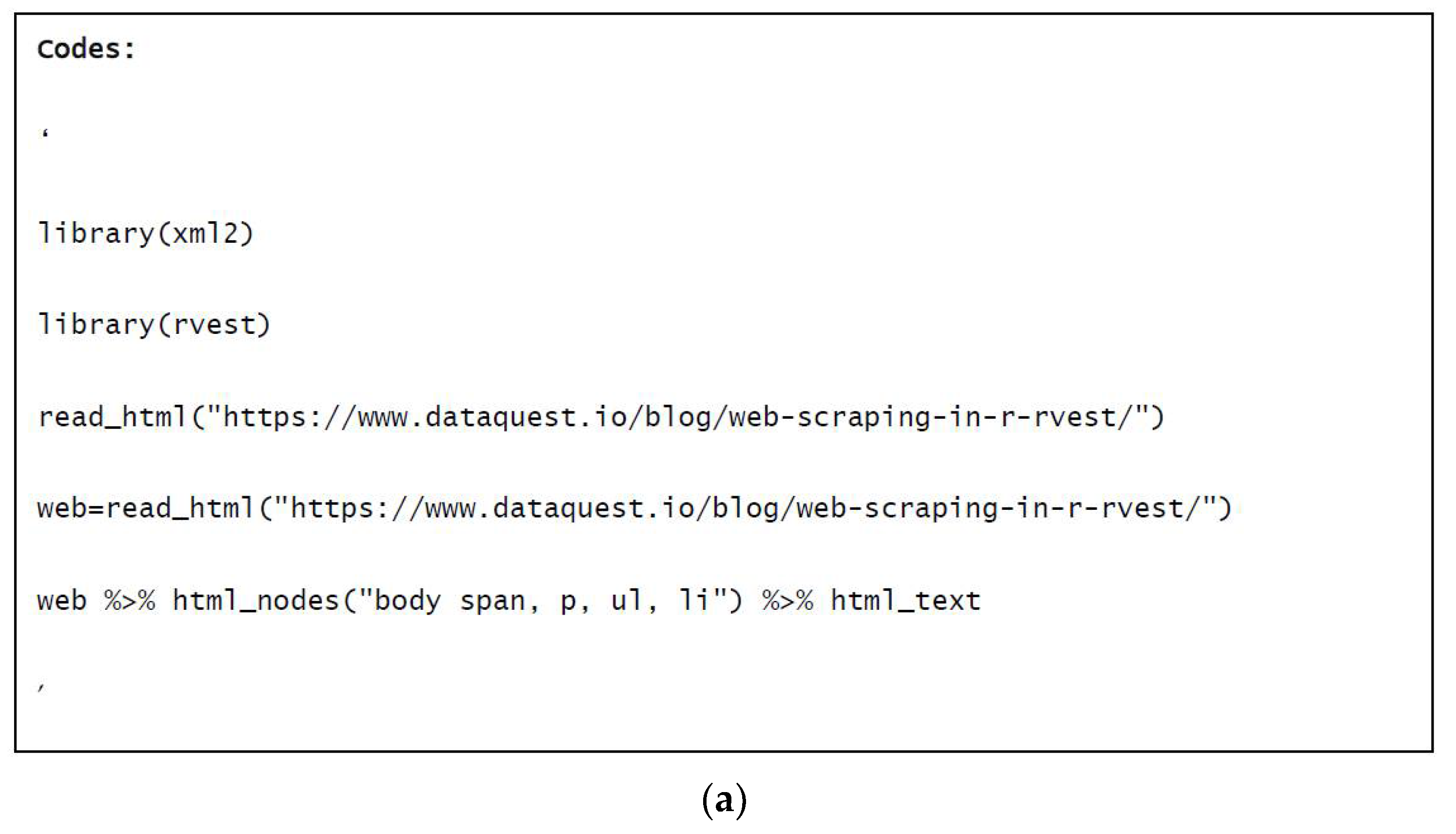
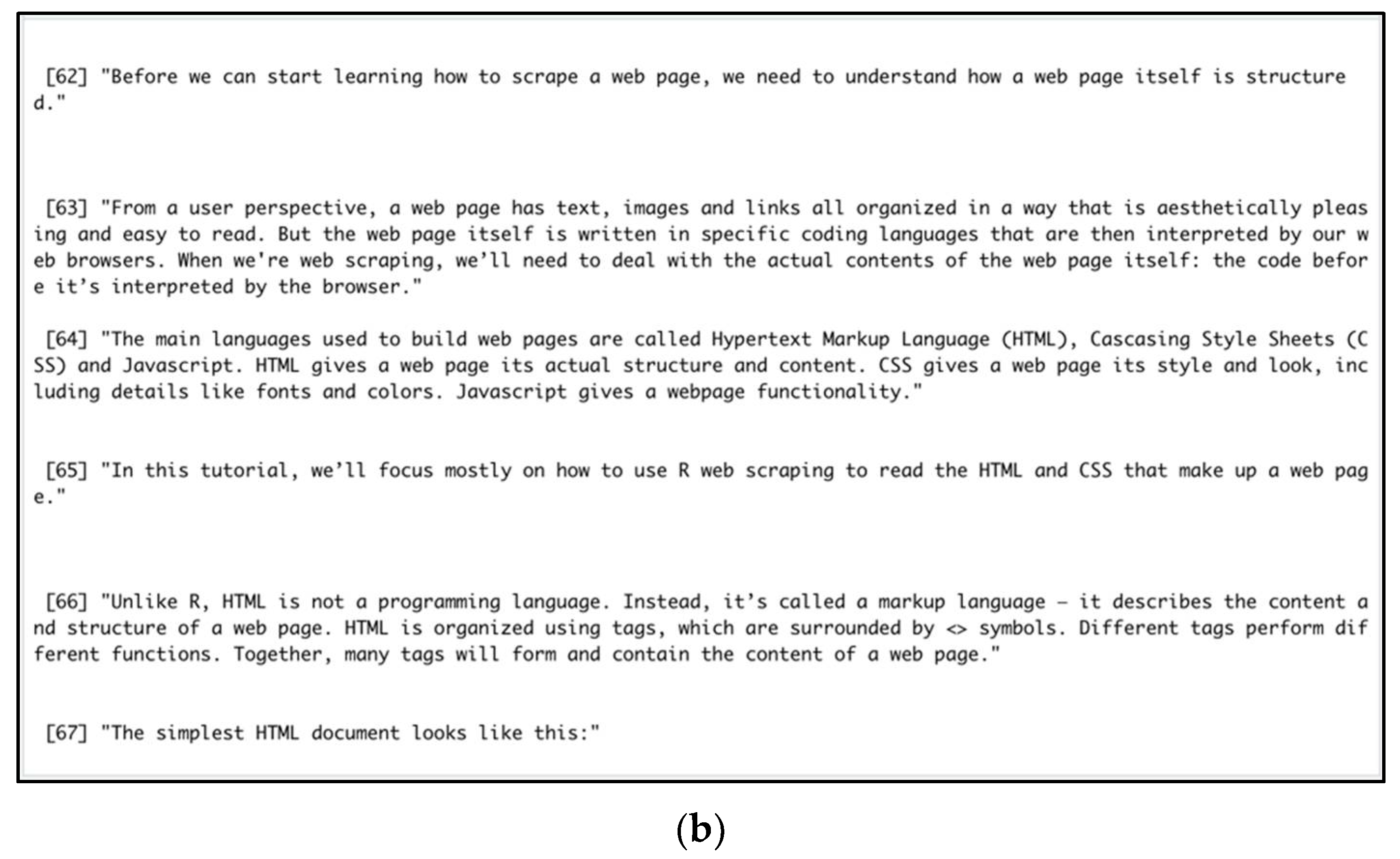
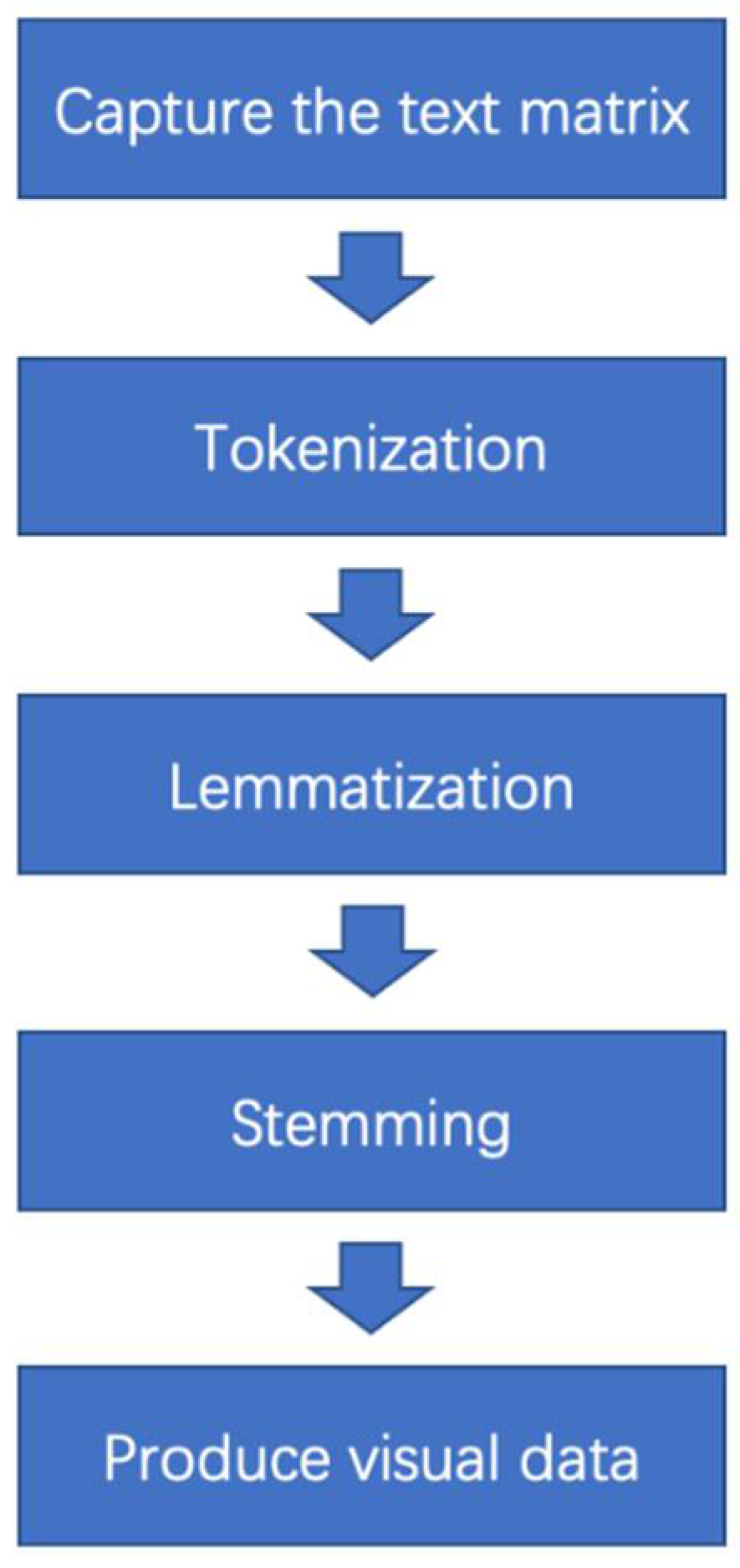
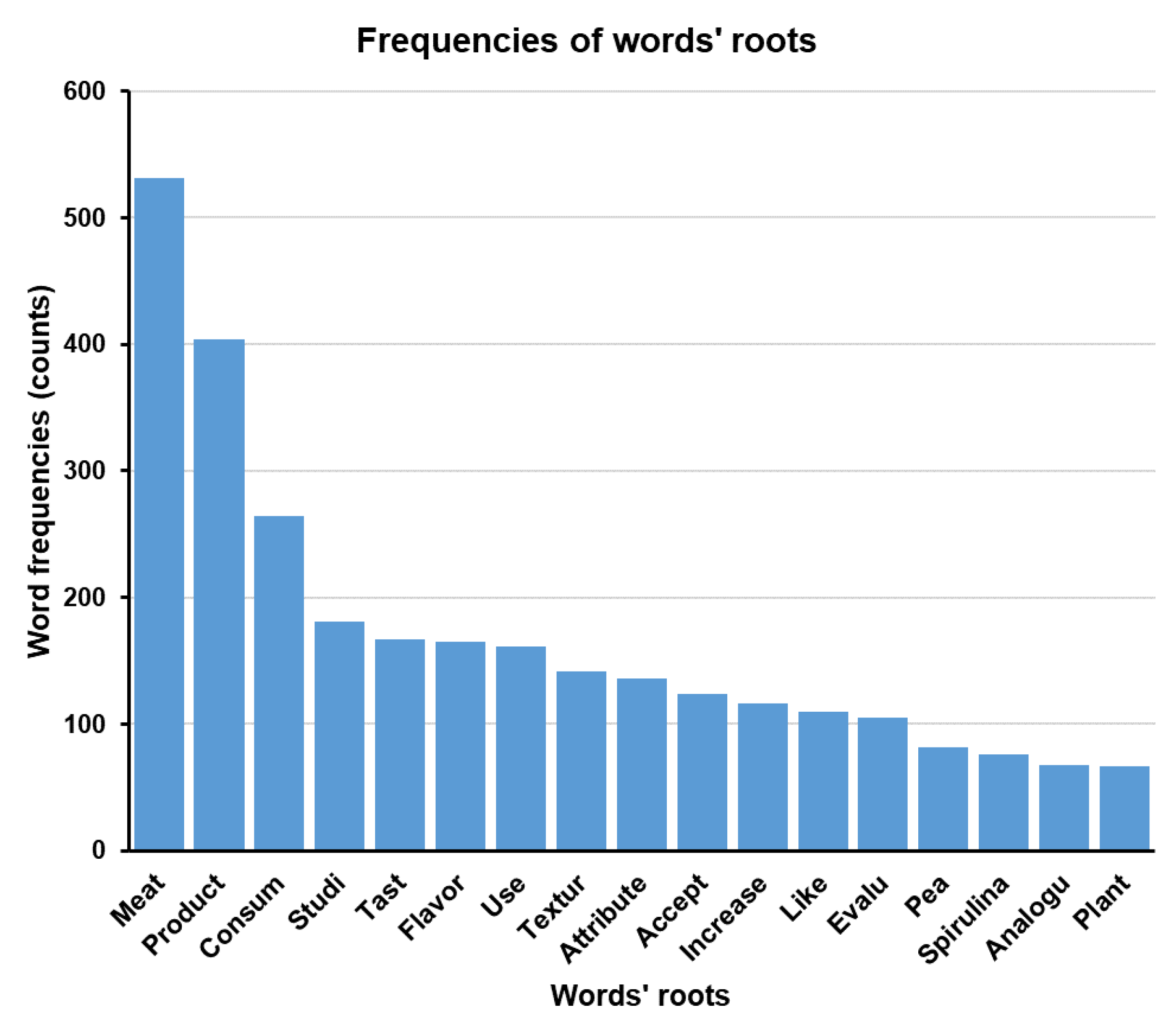
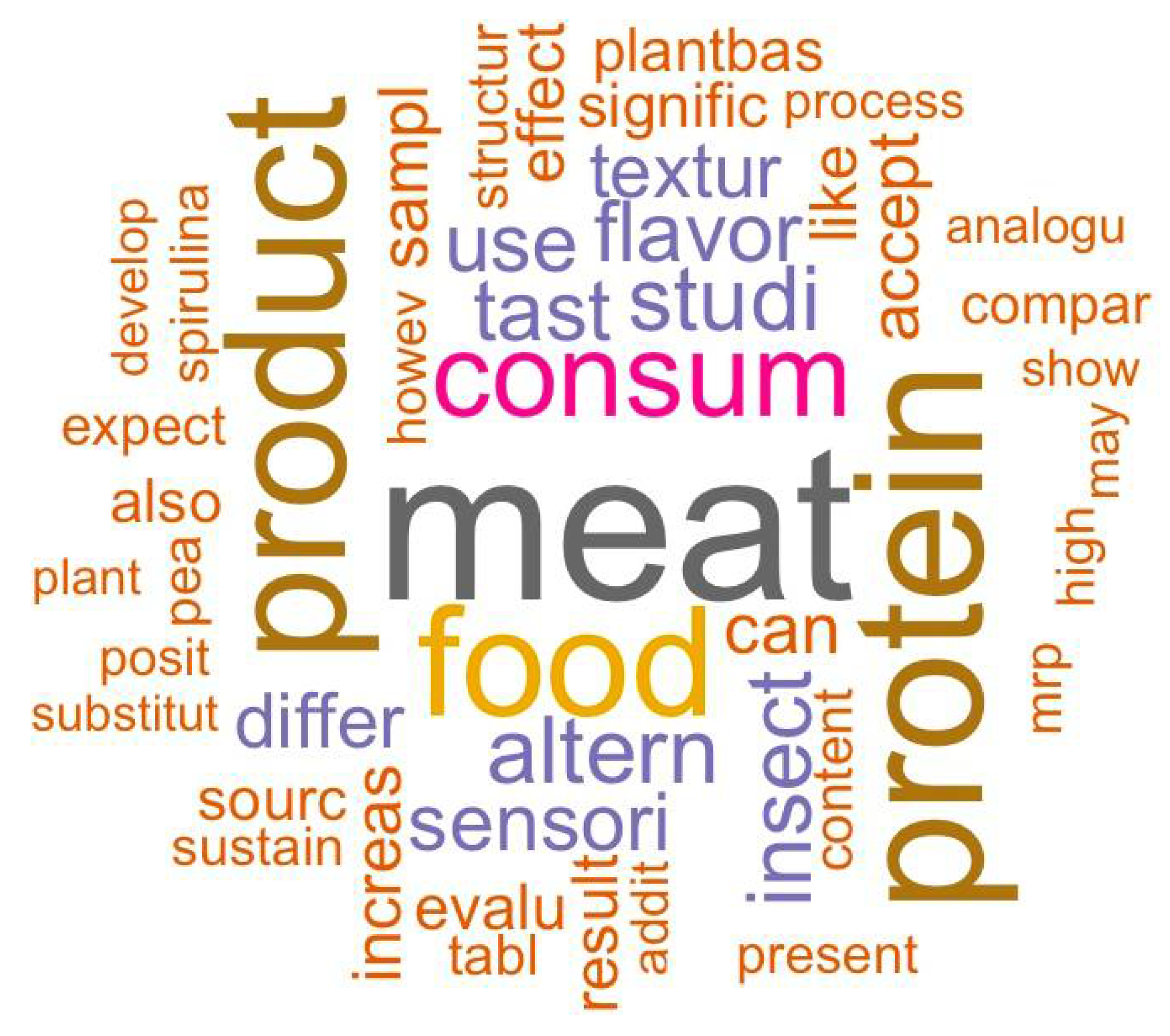
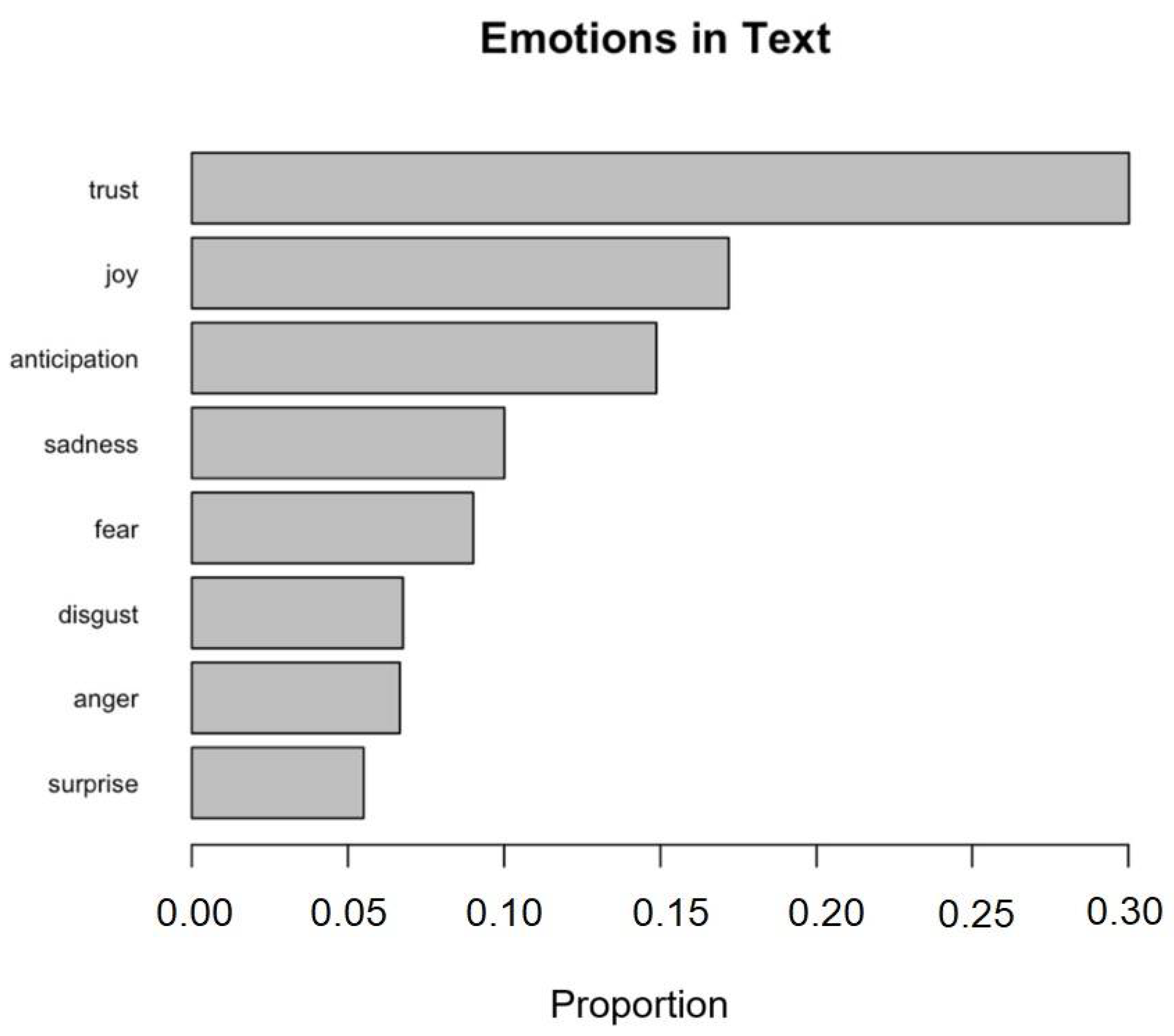
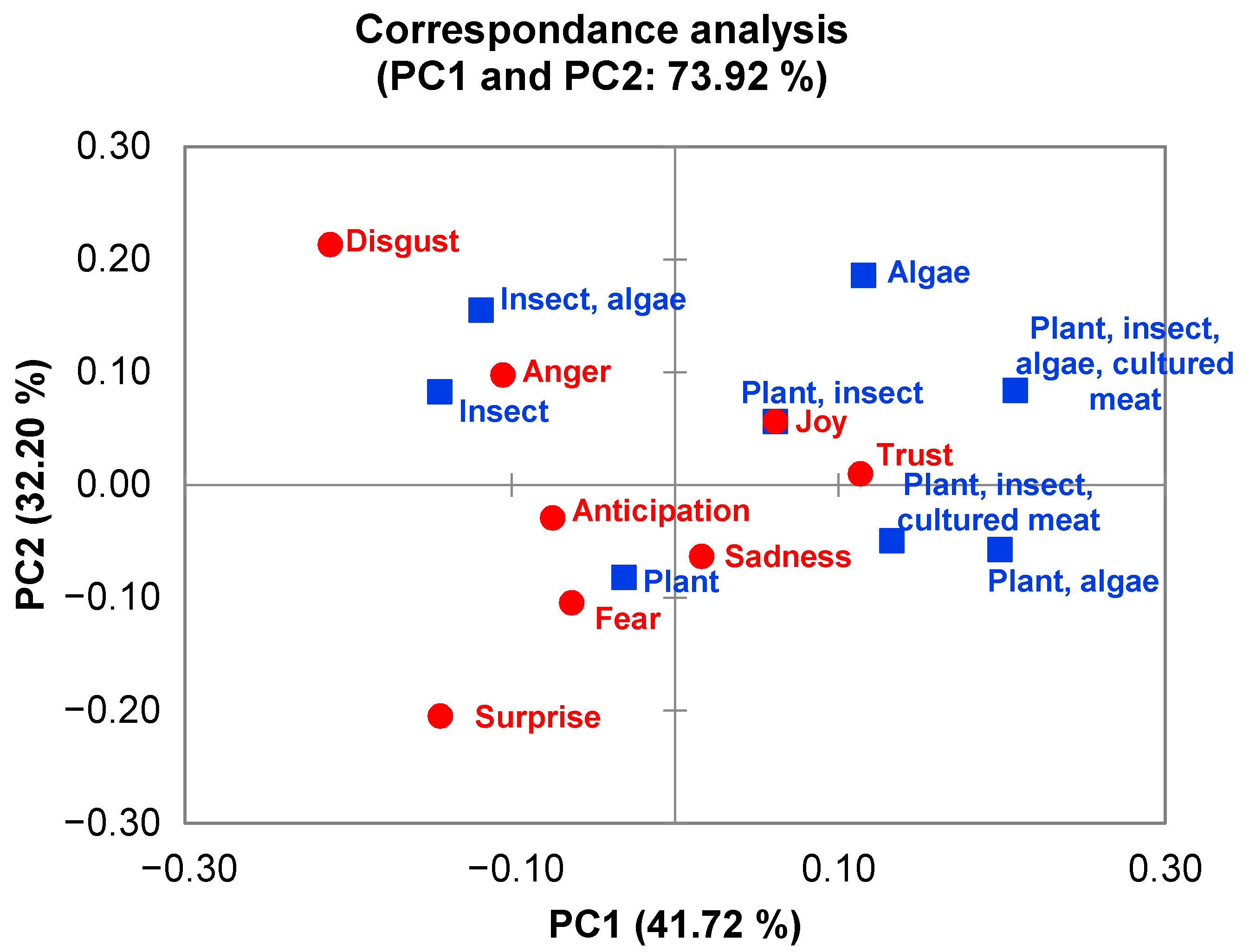
Publisher’s Note: MDPI stays neutral with regard to jurisdictional claims in published maps and institutional affiliations. |
© 2021 by the authors. Licensee MDPI, Basel, Switzerland. This article is an open access article distributed under the terms and conditions of the Creative Commons Attribution (CC BY) license (https://creativecommons.org/licenses/by/4.0/).
Share and Cite
Chen, Z.; Gurdian, C.; Sharma, C.; Prinyawiwatkul, W.; Torrico, D.D. Exploring Text Mining for Recent Consumer and Sensory Studies about Alternative Proteins. Foods 2021, 10, 2537. https://doi.org/10.3390/foods10112537
Chen Z, Gurdian C, Sharma C, Prinyawiwatkul W, Torrico DD. Exploring Text Mining for Recent Consumer and Sensory Studies about Alternative Proteins. Foods. 2021; 10(11):2537. https://doi.org/10.3390/foods10112537
Chicago/Turabian StyleChen, Ziyang, Cristhiam Gurdian, Chetan Sharma, Witoon Prinyawiwatkul, and Damir D. Torrico. 2021. "Exploring Text Mining for Recent Consumer and Sensory Studies about Alternative Proteins" Foods 10, no. 11: 2537. https://doi.org/10.3390/foods10112537
APA StyleChen, Z., Gurdian, C., Sharma, C., Prinyawiwatkul, W., & Torrico, D. D. (2021). Exploring Text Mining for Recent Consumer and Sensory Studies about Alternative Proteins. Foods, 10(11), 2537. https://doi.org/10.3390/foods10112537







